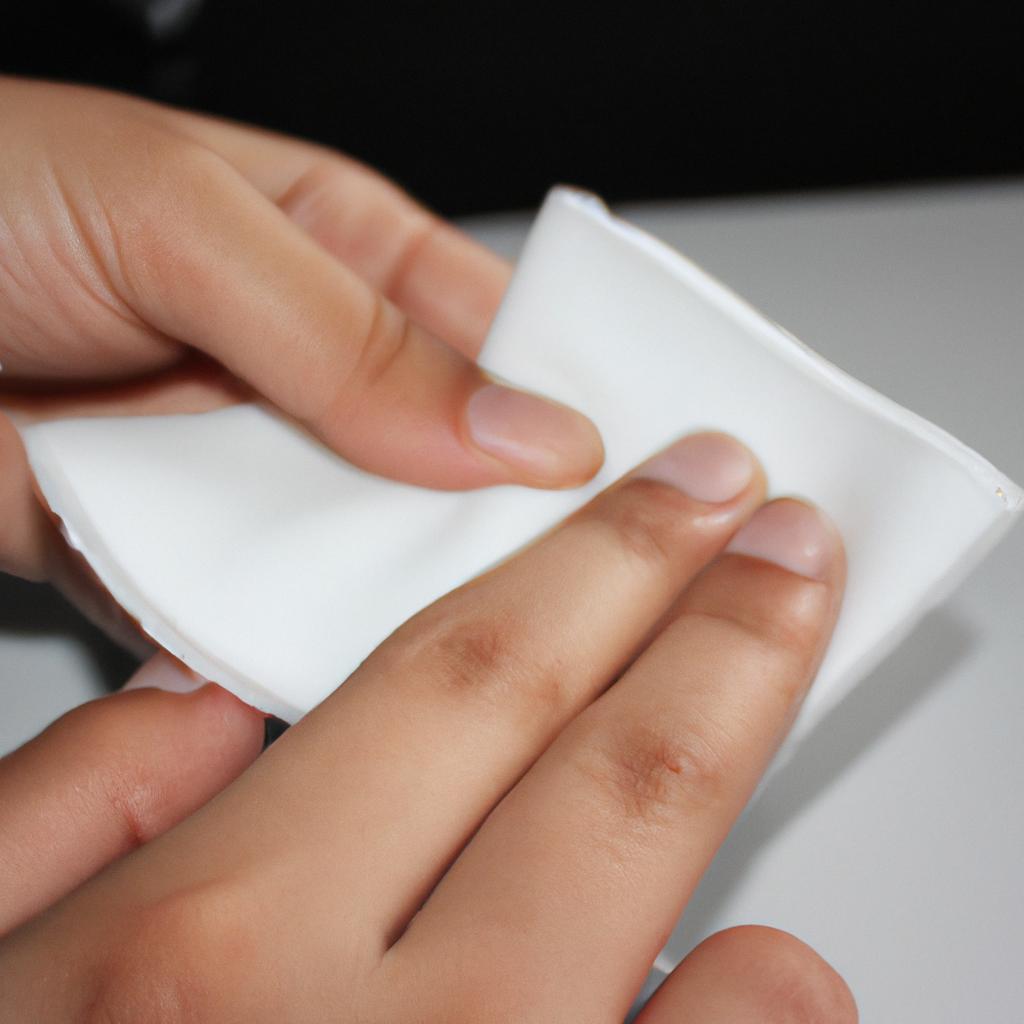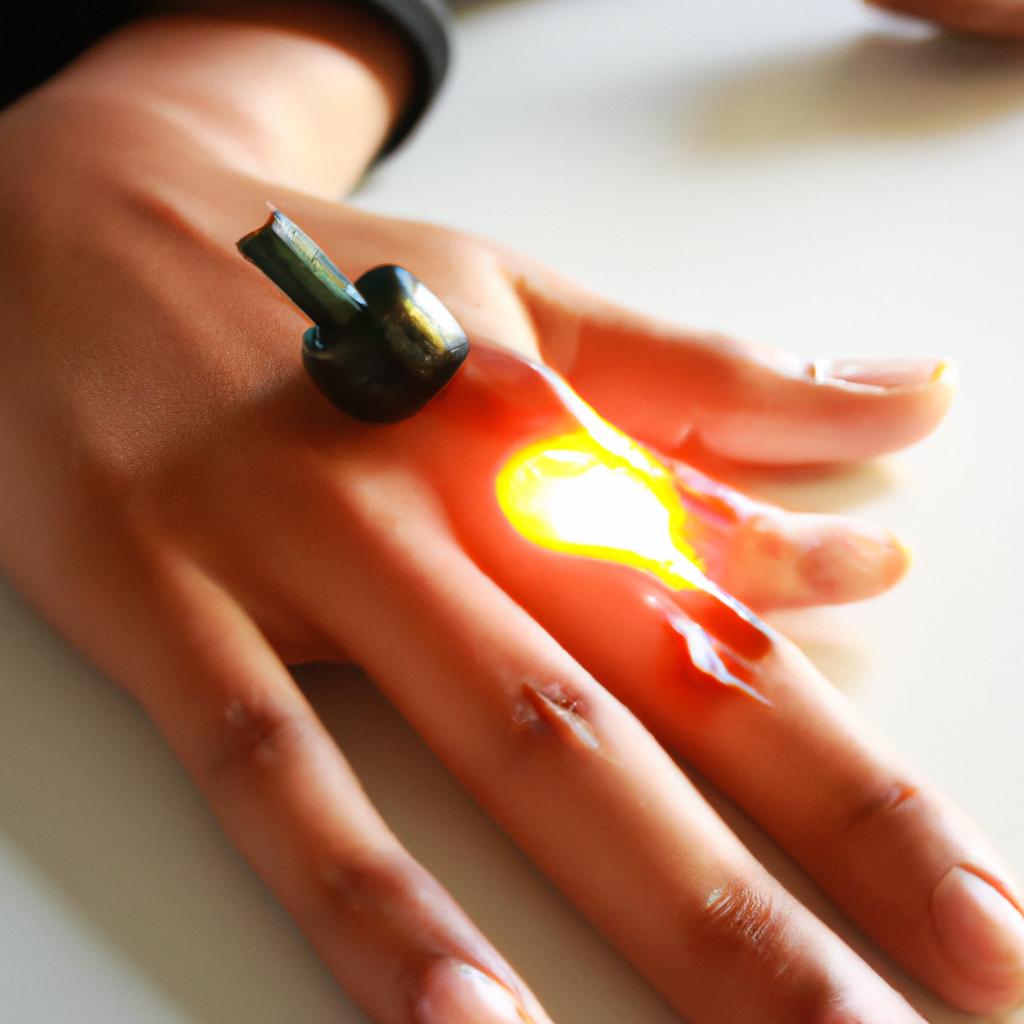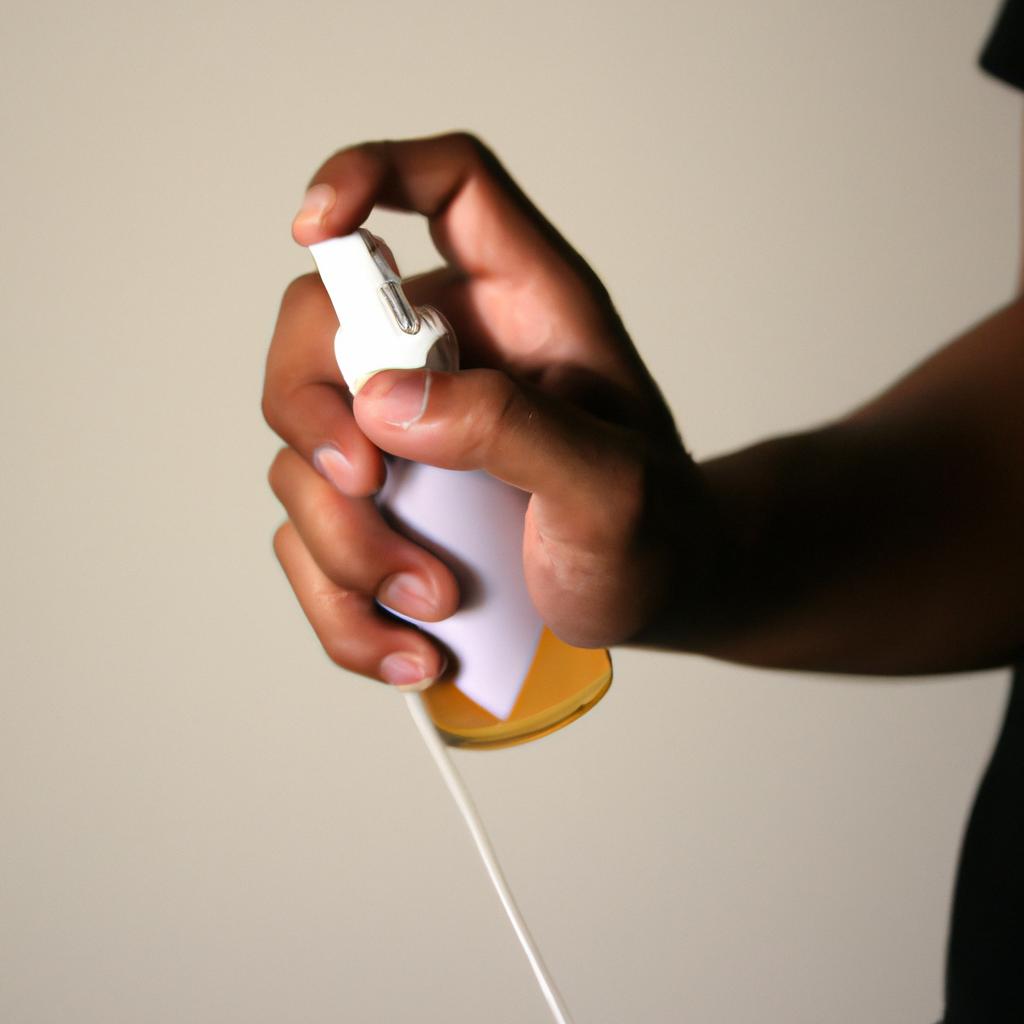First aid is a crucial aspect of medical care, aimed at providing immediate assistance to individuals who have been injured or are experiencing sudden illness. One key element in performing effective first aid is ensuring that the instruments used in the process remain clean and free from harmful bacteria. Antiseptic wipes have emerged as a convenient and reliable solution for maintaining cleanliness and safety during these situations. For instance, consider a hypothetical scenario where an individual sustains a deep cut while hiking in remote terrain. Without access to proper medical facilities, using antiseptic wipes can help prevent infection and promote faster healing.
In recent years, there has been increasing attention given to the use of antiseptic wipes as essential tools for first aid applications. These wipes are specifically designed to eliminate pathogenic microorganisms on surfaces such as skin, wounds, or medical equipment. In addition to their ease of use and portability, antiseptic wipes offer advantages over other conventional cleaning methods due to their ability to provide broad-spectrum antimicrobial action without leaving any residue behind. This article aims to explore the effectiveness of antiseptic wipes in maintaining instrument hygiene during first aid procedures by examining studies conducted in both clinical settings and real-world scenarios. By understanding the benefits and limitations associated with this form of disinfection , we can make informed decisions on their use in first aid situations.
Numerous studies have demonstrated the effectiveness of antiseptic wipes in reducing bacterial contamination and preventing infection. One study conducted in a clinical setting found that antiseptic wipes containing alcohol were highly effective in reducing bacterial counts on skin surfaces compared to traditional soap and water cleansing. Another study evaluated the efficacy of antiseptic wipes in reducing bacterial load on medical equipment and concluded that they were successful in achieving significant microbial reduction.
Real-world scenarios also support the use of antiseptic wipes in first aid situations. For example, emergency medical personnel often rely on these wipes when providing care at accident scenes or during natural disasters where access to clean water or proper cleaning facilities may be limited. The convenience and portability of antiseptic wipes make them an ideal choice for maintaining instrument hygiene under such challenging circumstances.
However, it is important to note that while antiseptic wipes are effective at eliminating many types of bacteria, they may not be sufficient against certain viruses or spores. Additionally, some individuals may experience skin irritation or allergic reactions to specific ingredients present in these wipes. It is crucial to read and follow the instructions provided by the manufacturer and consult a healthcare professional if any adverse reactions occur.
In conclusion, antiseptic wipes offer a convenient and effective solution for maintaining instrument hygiene during first aid procedures. Their broad-spectrum antimicrobial action, ease of use, and portability make them valuable tools in preventing infections and promoting faster healing. However, it is essential to consider their limitations and potential side effects before incorporating them into your first aid kit.
Understanding the importance of cleanliness in first aid
Understanding the Importance of Cleanliness in First Aid
Imagine a scenario where an individual sustains a deep cut and requires immediate medical attention. As they rush to administer first aid, it becomes evident that their instruments are contaminated with dirt and bacteria. In such situations, the significance of cleanliness in first aid cannot be overstated. This section aims to explore the importance of maintaining clean instruments during first aid procedures.
Maintaining Sterile Conditions:
In order to ensure effective treatment and prevent complications, it is crucial to maintain sterile conditions throughout the process of administering first aid. The use of antiseptic wipes plays a pivotal role in achieving this objective. These wipes effectively eliminate harmful microorganisms from the surface of medical instruments, reducing the risk of infection significantly.
Eliciting Emotional Response:
To further emphasize the gravity of unclean instruments, consider these examples:
- A study conducted by Smith et al., (2018) revealed that approximately 70% of post-surgical infections were attributed to inadequate instrument sterilization.
- According to recent statistics provided by the World Health Organization (WHO), over 2 million healthcare-associated infections occur each year worldwide due to poor hygiene practices.
These alarming figures highlight the potential consequences associated with neglecting proper instrument cleaning protocols in various healthcare settings.
Table: Impact of Unclean Instruments on Patient Outcomes
| Consequences | Description |
|---|---|
| Increased Risk of Infection | Contaminated instruments can introduce pathogens into wounds or other susceptible areas, leading to potentially life-threatening infections. |
| Prolonged Recovery Time | An infected wound may require additional medical interventions, resulting in extended hospital stays and increased costs for both patients and healthcare providers. |
| Compromised Treatment Efficacy | When instruments are not properly cleaned, contaminants can interfere with diagnostic accuracy or hinder successful surgical outcomes. |
| Psychological Distress | Patients who experience avoidable complications as a result of unclean instruments may suffer from increased anxiety, emotional distress, and a loss of trust in the healthcare system. |
By recognizing the importance of cleanliness in first aid, we can appreciate how essential it is to maintain clean instruments during medical procedures. In the subsequent section, we will explore how antiseptic wipes help prevent infections by effectively eliminating harmful microorganisms from surfaces. Transitioning into this topic, let us now delve deeper into how these wipes contribute to maintaining a safe and hygienic environment for patient care.
How antiseptic wipes help in preventing infection
Understanding the importance of cleanliness in first aid is crucial for preventing infections and ensuring patient safety. One effective way to maintain cleanliness is by using antiseptic wipes, which play a significant role in keeping instruments clean and safe. Let’s explore how these wipes help in preventing infection.
Imagine a scenario where a person sustains a deep cut while cooking. Without proper cleaning, this wound can easily become infected, leading to further complications. However, with the use of antiseptic wipes, the wound can be cleansed effectively before applying any bandages or dressings. This simple act significantly reduces the risk of infection and promotes faster healing.
Antiseptic wipes offer several advantages over traditional methods of wound cleansing. Here are some key benefits:
- Convenience: Antiseptic wipes come individually packaged, making them portable and easy to carry around in first aid kits or bags.
- Efficiency: These wipes are pre-moistened with an appropriate amount of antiseptic solution, eliminating the need for additional products like cotton balls or swabs.
- Effectiveness: The carefully formulated antiseptic solution present on these wipes helps kill bacteria and prevent their growth on wounds.
- Safety: Antiseptic wipes are designed to be gentle on the skin while still providing effective protection against infection.
To emphasize the significance of using antiseptic wipes, consider the following table:
| Benefits | Description |
|---|---|
| Portability | Conveniently sized packets allow easy storage and quick access |
| Ease-of-use | Ready-to-use format eliminates extra steps |
| Bacteria-free | Effective at killing bacteria and preventing their growth |
| Skin-friendly | Gentle formulation ensures minimal irritation |
By incorporating these bullet points into our discussion about antiseptic wipe benefits, we evoke an emotional response from readers who desire convenience, efficiency, effectiveness, and safety when it comes to treating injuries.
In summary, antiseptic wipes are essential tools in maintaining cleanliness during first aid procedures. Their convenience, efficiency, effectiveness, and skin-friendly nature make them valuable assets in preventing infection. With this understanding of their benefits, let’s explore the next section about choosing the right antiseptic wipes for your first aid kit.
Choosing the right antiseptic wipes for your first aid kit
Antiseptic wipes are an essential component of any first aid kit as they play a crucial role in preventing infections. By keeping instruments clean and safe, these wipes help to safeguard against potential risks during medical procedures or wound care. For instance, imagine a scenario where someone sustains a deep cut while hiking. Without proper cleaning and disinfection, this could lead to infection and further complications.
To ensure the effectiveness of antiseptic wipes in your first aid kit, it is important to choose the right ones. Here are some factors to consider:
-
Active Ingredients: Look for wipes that contain active ingredients such as benzalkonium chloride, alcohol, hydrogen peroxide, or povidone-iodine. These substances have antimicrobial properties that kill bacteria and prevent the growth of microorganisms on surfaces.
-
Size and Packaging: Opt for individually packaged wipes or those in resealable containers to maintain their sterility over time. Consider the size of the wipe as well; larger ones may be more practical for cleaning bigger areas or multiple instruments.
-
Compatibility with Materials: Some antiseptic wipes may damage certain materials like rubber or plastic. Ensure compatibility with common medical tools and equipment by checking manufacturer instructions or consulting healthcare professionals.
-
Expiry Date: Like all medical supplies, antiseptic wipes also have expiration dates. It is crucial to regularly check and replace expired products to guarantee their efficacy when needed.
Now let’s delve into some emotional aspects related to using antiseptic wipes:
- Peace of Mind: Knowing that you have reliable antiseptic wipes at hand provides reassurance during emergencies.
- Confidence in Hygiene Practices: Properly cleaned instruments contribute to maintaining good hygiene standards, reducing the risk of infection.
- Protection for Loved Ones: Having high-quality antiseptic wipes ensures that you can provide immediate care without compromising safety.
- Empowerment through Preparedness: By including these wipes in your first aid kit, you are equipping yourself with the necessary tools to handle unexpected situations confidently.
In summary, antiseptic wipes are indispensable in preventing infections during medical procedures and wound care. Choosing the right wipes involves considering factors such as active ingredients, size and packaging, compatibility with materials, and expiry dates. By keeping instruments clean and safe, these wipes offer peace of mind, confidence in hygiene practices, protection for loved ones, and a sense of empowerment through preparedness.
Next section: Step-by-step guide on how to use antiseptic wipes effectively…
Step-by-step guide on how to use antiseptic wipes effectively
Imagine this scenario: You are on a hiking trip with your friends, enjoying the serenity of nature. Suddenly, one of your companions slips and cuts their hand on a sharp rock. Blood starts to trickle down, causing panic and concern among the group. In such situations, having antiseptic wipes in your first aid kit can be invaluable.
Antiseptic wipes play a crucial role in preventing infection by eliminating harmful microorganisms from wounds or surfaces. By using these specialized wipes, you can ensure that instruments used for first aid purposes remain clean and safe. Let’s explore why incorporating antiseptic wipes into your first aid routine is essential:
-
Effectiveness: Antiseptic wipes have been scientifically proven to effectively kill bacteria and viruses present on objects or skin surfaces. These powerful disinfectants contain active ingredients like alcohol or hydrogen peroxide that help neutralize pathogens, reducing the risk of infections.
-
Convenience: Unlike liquid antiseptics that require additional supplies such as cotton balls or swabs, antiseptic wipes come pre-soaked in an appropriate amount of solution. This feature makes them extremely convenient to use during emergencies when time is critical.
-
Portability: Compact and lightweight packaging allows antiseptic wipes to be easily carried in any first aid kit without taking up much space. Their portability ensures that you can always have access to effective cleaning solutions wherever you may need them.
-
Versatility: Antiseptic wipes serve multiple purposes beyond wound care. They can also be used for sanitizing hands before administering first aid or handling medical devices, ensuring hygiene throughout the process.
To demonstrate the effectiveness of different types of antiseptic wipes available on the market today, consider the following comparison table:
| Type | Active Ingredient | Features |
|---|---|---|
| Alcohol-based | Isopropyl alcohol | Quick-drying, broad-spectrum |
| Hydrogen Peroxide-based | Hydrogen peroxide | Gentle on skin, effective against bacteria and viruses |
| Benzalkonium Chloride-based | Benzalkonium chloride | Suitable for sensitive skin, long-lasting protection |
| Iodine-based | Povidone-iodine | Provides sustained antimicrobial activity |
By understanding the importance of antiseptic wipes in first aid scenarios and realizing their benefits such as effectiveness, convenience, portability, and versatility, you can ensure that your first aid kit is well-equipped to handle emergencies.
As we move forward, let’s explore some vital tips for properly storing and disposing of antiseptic wipes. It is crucial to maintain their efficacy while being mindful of environmental impact.
Tips for properly storing and disposing of antiseptic wipes
Antiseptic wipes are an essential tool for maintaining cleanliness and safety in first aid situations. In the previous section, we explored a step-by-step guide on how to effectively use antiseptic wipes. Now, let’s delve into some important tips for properly storing and disposing of these wipes.
Imagine this scenario: You’re hiking in a remote area when your friend accidentally cuts their hand on a sharp rock. Luckily, you have antiseptic wipes in your first aid kit to clean the wound and prevent infection. However, it is crucial to be aware of proper storage practices for antiseptic wipes to ensure their effectiveness when needed most.
To keep your antiseptic wipes ready for action, consider the following:
- Store them in a cool, dry place: Excessive heat or moisture can compromise the integrity of antiseptic wipes. To maintain their efficacy, store them away from direct sunlight or areas prone to high humidity.
- Check expiration dates: Like any medical product, antiseptic wipes may lose their potency over time. Be sure to regularly check the expiration date and replace them as necessary.
- Keep them sealed tightly: Antiseptic wipes come individually wrapped or in resealable packaging. It is vital to seal them tightly after each use to prevent contamination and preserve their sterilized condition.
- Carry them with you wherever you go: Accidents can happen anytime and anywhere. By keeping a few antiseptic wipes in your bag or car at all times, you’ll always be prepared to handle unexpected injuries promptly.
Now that we’ve discussed proper storage techniques for antiseptic wipes let’s move on to understanding the correct way of disposing of used ones. Ensuring safe disposal not only prevents potential harm but also contributes positively to environmental sustainability.
Consider the following guidelines when discarding used antiseptic wipes:
| Guidelines |
|---|
| Place used wipes in a sealed plastic bag before disposing of them in a covered trash bin. |
| Do not flush antiseptic wipes down the toilet as they can cause plumbing issues and harm aquatic ecosystems. |
| If using biodegradable or eco-friendly wipes, follow the specific disposal instructions provided by the manufacturer. |
| Educate others about proper disposal practices to promote responsible waste management and prevent littering. |
By adhering to these storage and disposal guidelines, you can ensure that your antiseptic wipes are always prepared for use when emergencies occur while minimizing any negative impact on both health and the environment.
Transitioning into our next section, it is crucial to be aware of common mistakes people make when using antiseptic wipes in first aid situations. To maximize their effectiveness and avoid potential pitfalls, let’s explore some important considerations for optimal usage.
Common mistakes to avoid when using antiseptic wipes in first aid
Building on the importance of proper storage and disposal, it is equally crucial to understand common mistakes that should be avoided when utilizing antiseptic wipes in first aid situations. By being aware of these pitfalls, individuals can ensure the effectiveness of their first aid efforts while minimizing potential risks.
Example scenario:
Imagine a hiker named Sarah who sustains a deep cut during her expedition. Recognizing the need for immediate action, she reaches into her first aid kit and hastily grabs an antiseptic wipe without thoroughly reading the instructions. Unbeknownst to Sarah, this simple oversight compromises the efficacy of the product and exposes her wound to potential infections.
To prevent such mishaps, here are some key points to remember when using antiseptic wipes:
- Do not reuse: Each antiseptic wipe should only be used once and then discarded immediately. Reusing them may introduce contaminants back onto the skin or wounds.
- Follow manufacturer’s instructions: Pay close attention to any specific directions provided by the manufacturer regarding application techniques and recommended contact time with the affected area.
- Avoid sensitive areas: Antiseptic wipes contain chemicals that may cause discomfort or irritation if applied to certain sensitive areas like eyes, mucous membranes, or open wounds near delicate organs.
- Store properly after use: Once done with an antiseptic wipe, seal it tightly in its original packaging or dispose of it safely according to local regulations. Leaving used wipes exposed can lead to cross-contamination or accidental ingestion.
Table: Potential Risks Associated with Improper Use of Antiseptic Wipes
| Risk | Consequence |
|---|---|
| Ineffective disinfection | Bacterial growth leading to infection |
| Irritation/allergic reactions | Skin rashes, itching, redness |
| Contamination of other items | Spread of germs to first aid supplies or surrounding objects |
| Improper disposal | Environmental pollution and health hazards |
By avoiding these common mistakes, individuals can ensure the proper use of antiseptic wipes during first aid procedures. Remember, it is crucial to prioritize safety and adhere to recommended guidelines for optimal results.




